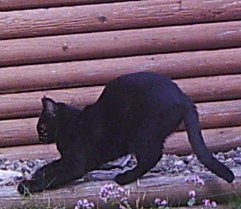Marking territory - getting to the bottom of microbe question

Ever wondered why cats insist on rubbing their faces against you, against household objects and other cats? Ever despaired at your cat's predilection for shredding furniture or pooping in inappropriate places? It might be all about scent marking.
Cats communicate through scent, and they use scent to mark their territory and objects within it (for scent purposes you count as an 'object'). Cats have a number of scent glands. There are the temporal glands on either side of the forehead between the eye and ear and others around the lips, particularly at the corners. These are called perioral glands.
Cats also have scent glands in the tail - caudal glands - as well as anal glands. There are likely to be scent glands on cat's feet as well (it scents as it shreds). All of these glands produce secretions which the cat smears on various objects. The cat's objective is to have an environment which smells like 'home'.
Recently studies of feline scent markers have concentrated on the particularly rich variety of scents produced by a cat's anal glands. If you have two or more cats, you have probably observed that one cat will smell another cat's anus after that cat returns from an excursion outdoors. By doing this a cat can find out how the other cat is feeling, what it has eaten recently, its state of health and where it has been. It's so much more informative than a handshake or a hug.
A cat's anal sacs produce odorus oily substances of a type used by many mammals to warn visitors that they are entering somone's else territory. Recent studies on dogs, coyotes and wolves have identified a number of short chain free fatty acids (Fatty acids are the building blocks of fat) in anal sacs which are partially responsible for the odors used for marking territory.
Recently a group from the Genome Center at the University of California studied the organic composition of feline anal sacs. The question they wanted to know is whether the cat produced its own smell, or if the distinct odour resulted from bacteria which had colonized the cat's glands. (This matters because, for example, a course of antibiotics might completely change a cat's odour, causing disruptions in the feline society of a household or neighborhood.)
The scientists cultured bacteria isolated from the anal sac. Also volatiles produced by the cultured bacterial were analysed and compared to chemicals extraced directly from the cat's anal sac. This study showed that the cat which they studied had a relatively narrow spectrum of different bacteria with three types predominating, and the most abundant bacteria in the anal sac are probably also part of most feline gut biomes.
These were: Bacteroides fragilis, Tessaracoccus, and Finegoldia magna.
Bacteroides are gram-negative, anaerobic, bile-resistant bacteria previously found in the gut where they make up approximately 25% of the intestinal gut microbiota.
Finegoldia magna is part of the normal flora of the gastrointestinal and genitourinary tract.
Tessaracoccus is a Gram-positive, non-spore-forming, anaerobic bacteria which belongs to the Propionibacteriaceae family, members of which are found in the intestinal tracts of many animals.
So what produces the smell from anal glands? It's a complex chemical brew. In total, 127 unique substances were found in anal sac secretions, 67 volotiles were isolated from bacterial culture, and 51 compounds were found in both anal sac and bacteria samples. Those of a scientific disposition can find more details in this recently published paper (ref).
It seems that bacteria, and not the cat itself, produce many of the scents used by the cat to communicate. But there are still a number of questions remaining. For example, how different are the bacteria in anal sacs in different cats? If indeed the volatiles produced by the bacteria are used by cats for marking territory, these volatiles must be sufficiently different to identify a single cat, or at least an individual group of cats. Secondly, if the cats are raised in the same household, are their anal gland scents similar?
We know from studies of human intestinal flora that individuals living together have more similar gut microbiota than individuals from different households. So perhaps the same applies to cats from the same household.
The group from the Genome Center at the University of California wants to expand their recent study to answer some of these questions. So we probably will hear more about scent and anal sacs in the future.
Journal Reference:
Mei S. Yamaguchi, Holly H. Ganz, Adrienne W. Cho, Thant H. Zaw, Guillaume Jospin, Mitchell M. McCartney, Cristina E. Davis, Jonathan A. Eisen, David A. Coil. Bacteria isolated from Bengal cat (Felis catus × Prionailurus bengalensis) anal sac secretions produce volatile compounds potentially associated with animal signaling. PLOS ONE (2019) 14(9) https://journals.plos.org/plosone/article?id=10.1371/journal.pone.0216846
